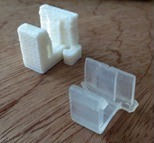Methods for printing products in 3D printers
- Boaz Zer
- Aug 6, 2023
- 3 min read
Updated: Aug 18, 2023

Stereolithography (SL)Stereolithography is the first method that appeared in the name of commercial 3D printing. It is a simple and accurate method for creating three-dimensional structures based on the hardening of a liquid polymer resin that reacts to light, using a laser. The laser beam is directed into a container of liquid resin and scans in an XY matrix layer by layer of the planned structure while it sinks into the liquid on top of a cylinder.Common applications for Radel:• Cases and trays for sterilization• Surgical instruments and dental instruments• Medical products
DLP digital light processingDLP has a lot in common with the stereolithography method. The DLP is a very accurate method and here too photopolymer is used to design three-dimensional shapes. The method has several advantages over stereolithography both in speed and in the volume of the polymer liquid container required to perform it. Different from the previous method that we were familiar with, this time a light beam is used that originates from an incandescent lamp that is directed by a mirror and is focused by a lens.
Melted / glued / meltedThe different melting methods work on a common principle of melting compressed powder layers using a laser. The laser beam scans the XY matrix and "cooks" the powder layer by layer which hardens until the construction of the desired configuration is completed.
FDM / FFF extrusionAccording to this method, a thermoplastic cable is melted using a hot print head, layer by layer according to the information entered. It is quite similar to the film printers of the past, except that now at the end of the print the printer moves to the next layer when the liquid cable in the print head cools quickly on the model and hardens. The printing results change before the shape of the model and the materials used. Printing can be slow in certain situations and sometimes the problem of adhesion of layers arises.
Glue injection printersIn these printers, powder familiar to us from the melting printers is mixed as well as adhesive ink that is poured over the powder layer by layer according to the construction plan. A roller spreads an even layer of powder on the print bed. The printing is done on a cylinder that is part of the printing bed and goes down a step with each printing round as the adhesive ink connects the powder to the desired shape.
Material injection printerIn this printer it is possible to print in a combination of different materials with several print heads that inject the molten material layer by layer. That is why it is possible to combine different characteristics and connect materials with different properties to create a configuration with unique capabilities. This is a very accurate method that achieves a highly finished result.



The field of 3D printers is quite new and vibrant. There are many variations on this theme and we can find printers of various types and species for every purpose. Printers have varying capabilities and their costs accordingly. There is no doubt that the world of 3D printers is only in its infancy and the potential is huge and will reach every home. In the meantime, the 3D printers open up new possibilities for us to develop prototypes with great speed and precision and to polish our product before we go out to create mass.If you are about to develop a product that includes plastic parts, or if you have an idea for a product,I invite you to send an email with your contact information to the following address:info@plastomold.com




Comments